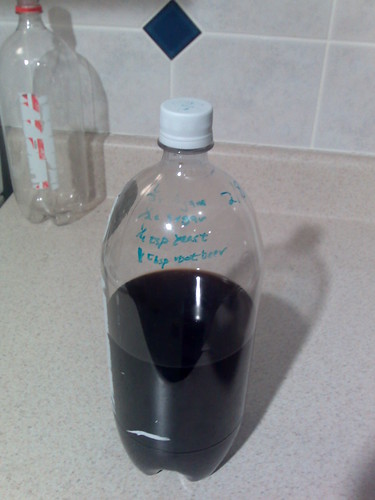I have recently starting getting into the exciting world of brewing my own root beer and I'm loving it. Over the past few months I've been learning about sourdoughs (which may lead to a separate post sometime), and that led me to learn about other fermented foods. Two things have really inspired me to start trying things on my own at home that I never would have thought I could do.
The first is an incredible
website belonging to Professor David B. Fankhauser. The second is a book called
Wild Fermentation by Sandor Ellix Katz.
Dr. Fankhauser's Cheese Page is one of the best sites out there covering the basics of home cheesemaking. (And he's local!) I haven't tried any cheeses yet, but as I was browsing through the site, I saw
the root beer recipe and knew that I had to try it right away. It's really easy, and I think the results are pretty tasty. The root beer does have a beery / yeasty flavor to it that I don't mind, but my girlfriend is not a big fan. This brew is definitely not like the liquid candy that you would buy at the grocery store. Here's the basic recipe (but definitely check out Fankhauser's page for the full details):
1 cup sugar, 1/4 tsp. yeast, 1 tbsp. root beer extract, 2 liters water.
Leave out on the counter for 3 - 4 days; put into fridge overnight.
That's it!
I also tried the ginger ale and cream soda recipes on the site and I came up with somewhat less drinkable sodas. The root beer extract is a really powerful flavor and I think it matches up a little better with the beery flavor, whereas the lighter flavors of the ginger ale and cream soda are more easily over-powered. I plan on trying again with some champagne yeast I got from The Party Source. The first time around I just used regular old baking yeast from the grocery.
In my most recent batch of root beer I made a minor modification in an attempt to make it at least a little bit less bad for me (since I've started drinking the stuff all the time). I substituted some of the sugar with a sweetener called
agave nectar. The main advantage of agave is that it has a lower
glycemic index. I substituted half of the sugar (1/2 cup) with agave. Most everything I could find said to reduce the volume of agave when substituting it for sugar since agave is supposed to be sweeter so I used 1/3 cup in place of the 1/2 cup sugar. After I mixed it up I started reading more about agave and I found out that this is the same plant that is fermented to make tequila -- I was starting to worry that I was making tequila flavored root beer! But no worries, it tastes just fine. Another way to have approached it would have been to try brewing the root beer with less sugar and then adding in the agave after. There is a limit to how low you can go with the sugar because that's the food for the yeast, and I don't know what the limit is yet.
I haven't made any sodas with the champagne yeast yet, but if it turns out well I've got all kinds of crazy ideas for sodas I could make. I've started the search for unusual flavoring oils and started researching other beverage recipes. :) I can't wait to do more experimenting!





